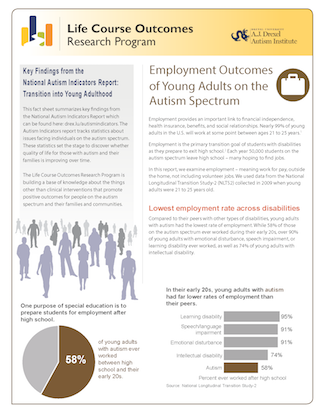Employment and the Youth with Autism Spectrum Disorders
Current Landscape of Employment for ASD

Looking Back: Where We Came From
In the past, expectations for youth with disabilities were often low. Options were limited. And the quality of life for most people with disabilities was far below their non-disabled peers. In the past, the work culture of many companies was non-inclusive with little awareness of the value people with disabilities, including those with autism spectrum disorders (ASD) could bring to the workplace. Qualified candidates with disabilities, including those with ASD, were often left out of the hiring pool leading to financial difficulties as well as emotional stress. Many individuals were never given a chance to even explore employment options as even well-meaning people believed community employment was not possible. Those that did work, often worked for low wages in segregated workshops doing monotonous tasks. These low expectations and segregated practices resulted in individuals with disabilities and employers both missing valuable opportunities and resources.
The good news is that many communities are recognizing the skill, talents and value of individuals with ASD and other disabilities. Myths and negative assumptions are being challenged. And youth with ASD are being supported to view their future as a community member in community employment. Outcomes still have much room for improvement, however awareness of the faulty thinking of the past and raising expectations has resulted in changes in employment policy, practice and opportunity for youth and adults with disabilities.
Current Landscape of Employment
Meaningful employment is a life goal for most adults, including those with ASD. Employment is often referenced as a hallmark of successful adult life. In the school years, transition plans and services focus heavily on preparing the transition age youth for employment and careers following high school. Despite this attention, employment outcomes for individuals with ASD remain concerning.
The National Longitudinal Transition Study-2 found that in their early 20s, young adults with autism had far lower rates of employment than their peers.
Percentage of youth that ever worked after high school
- Learning disability: 95%
- Speech/language impairment: 91%
- Emotional disturbance : 91%
- Intellectual disability 74%
- Autism : 58%
The survey results above and the data cited in the following tabs reflect the need to explore more fully the possibilities for employment as well as the types of instruction, preparation, services, and support that should be considered to create and sustain success. Individuals with ASD across the spectrum have skills, talents and are able to contribute meaningfully to the workforce given well-matched opportunities, the necessary preparation, and appropriate supports.